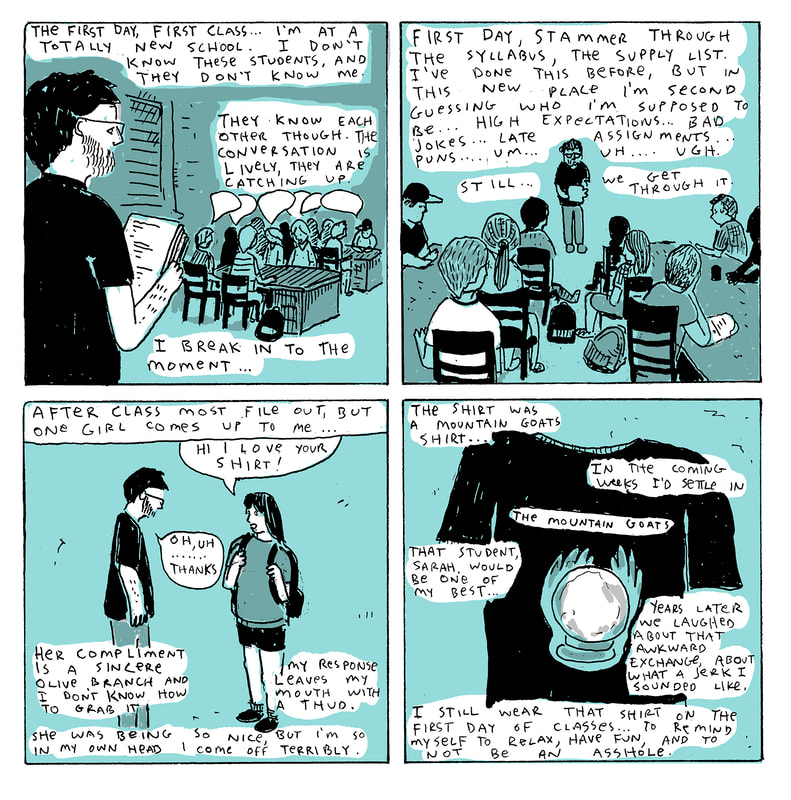Zines and Comics
Narrative is an important part of all of my work. I find that using a story helps frame ideas and lets me find a place for each project. I often think of different bodies of work as different parts of a larger ongoing story. Across my work motifs and characters appear again and again, forming connections across media and exhibitions, growing a relationship between ideas and pieces over time.
Prior to the COVID-19 pandemic my work had consisted of prints on paper and large scale site specific installations using wheat pasted prints. 2020 found me unable to work in the studio at my school and traveling for exhibitions unfeasible. Quarantined at home I dove deep into my practice of journaling and writing, reigniting my first artistic impulse: comics. While comic books and graphic storytelling had remained an important aspect in how I created my work, it had been over a decade since I had tried producing a comic. Inspired by the assignments of Lynda Barry and Ivan Brunetti, I began producing small comics using my journals as raw material.
The play that Zines and Comics affords me is important in understanding how a narrative develops. Comics in particular allow me to more directly engage with ideas and observations that relate to my other work. My installations and prints often come from a place of thinking about the future, while my Zines and comics often engage with my present and past.
In addition to producing my own comics and zines I've found my work developing further into questions about community expression. A shift has begun in my work- looking at how community based projects through workshops can develop spaces for multiple voices. I'm interested in the power of publishing as a way to connect and amplify voices and ideas that might not otherwise be heard. I've started to consider the potential of leaflets, pamphlets, and surveys as a means to ask simple questions with complex and varied answers. While my work continues to evolve it remains rooted in the connectivity of sharing printed material- the impact that handing a piece of paper with a story or image on it can have on another person.
Narrative is an important part of all of my work. I find that using a story helps frame ideas and lets me find a place for each project. I often think of different bodies of work as different parts of a larger ongoing story. Across my work motifs and characters appear again and again, forming connections across media and exhibitions, growing a relationship between ideas and pieces over time.
Prior to the COVID-19 pandemic my work had consisted of prints on paper and large scale site specific installations using wheat pasted prints. 2020 found me unable to work in the studio at my school and traveling for exhibitions unfeasible. Quarantined at home I dove deep into my practice of journaling and writing, reigniting my first artistic impulse: comics. While comic books and graphic storytelling had remained an important aspect in how I created my work, it had been over a decade since I had tried producing a comic. Inspired by the assignments of Lynda Barry and Ivan Brunetti, I began producing small comics using my journals as raw material.
The play that Zines and Comics affords me is important in understanding how a narrative develops. Comics in particular allow me to more directly engage with ideas and observations that relate to my other work. My installations and prints often come from a place of thinking about the future, while my Zines and comics often engage with my present and past.
In addition to producing my own comics and zines I've found my work developing further into questions about community expression. A shift has begun in my work- looking at how community based projects through workshops can develop spaces for multiple voices. I'm interested in the power of publishing as a way to connect and amplify voices and ideas that might not otherwise be heard. I've started to consider the potential of leaflets, pamphlets, and surveys as a means to ask simple questions with complex and varied answers. While my work continues to evolve it remains rooted in the connectivity of sharing printed material- the impact that handing a piece of paper with a story or image on it can have on another person.









